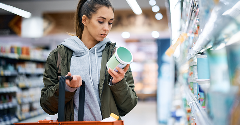News
Creating better texture in dairy alternatives
26 Sep 2018The market for dairy alternatives continues to rise, but creating appealing, creamy textures that mimic traditional yoghurt or cheese can be a major stumbling block. For suppliers, this challenge has become fertile ground for innovation.

The market for products like non-dairy beverages, frozen desserts, and vegan cheese and yoghurt alternatives has skyrocketed in recent years. In Western Europe alone, more than 2,500 vegan alternatives to dairy products have been launched in the past decade, according to Innova Market Insights.
Taste – alongside price, nutrition and convenience – is among the most important factors influencing food choices, but much of what consumers think of as ‘taste’ is inextricably linked to texture. Flavour is one thing, but manufacturers must also pay attention to whether a yoghurt substitute is grainy or too watery, or how a vegan ice cream alternative melts in the mouth.
The problem often stems from the different proteins in plant-based products. Whether they are made from pulses, nuts or cereals, their proteins do not have the same functionality as those from dairy.
A recent report from Palsgaard
highlights functional problems with dairy alternative drinks, and says stability is among the most prominent challenges, including issues such as sedimentation and separation. It suggests using emulsifiers like vegetable fats and oils to emulate the texture of dairy proteins, while stabilisers can help improve viscosity and mouthfeel.
However, the way in which such systems are used depends on the base ingredients, whether soy, rice, or almond, for example, and whether the recipe calls for a paste, powder or liquid.
Hydrosol, part of the Stern-Wywiol Group, has also responded to rising demand in this area with stabilising and texturing systems that mimic the properties of a wide range of cow’s milk products. These include fermented desserts based on alternatives like almond milk, and a system of modified starch, hydrocolloids and plant fibres, which can be modified to emulate the texture of yoghurt. The company also provides alternatives to cream cheese that can be used as a base for vegan cheese alternatives, and ingredient systems to create creamy soft-melt vegan ice creams.
Meanwhile, DuPont Nutrition & Health is working with protein blends to improve product taste and texture. Blending pea and soy protein, for example, may help manufacturers minimise chalkiness and improve solubility, while creating a better flavour than either could deliver on its own.
For manufacturers, achieving the right texture is vital, but it is also important to keep ingredient lists short and to consider whether to avoid artificial ingredients, as consumers of vegan dairy alternatives may be more sensitive to such ingredients than the general population.
According to Innova Market Insights, clean label claims in the dairy alternatives sector are more prominent and rising faster than in dairy, leading to a surge in naturally derived stabilising ingredients like gellan gum, guar gum and locust bean gum.
The dairy alternative sector has seen enormous growth, but there is still plenty of room for it to grow – especially as major players in the ingredients sector help find new ways to create creamier, tastier, plant-based products.
Related news

Value is a top priority for today’s F&B consumers
3 Apr 2025
Research from global consultancy Hartman Group suggests there are six core values that brands must tap into to connect with consumers’ needs.
Read more
Future F&B flavours favour exploration and explosive taste profiles
25 Mar 2025
Exploration and experimentation will define the future of flavour, according to Mintel, as consumers seek out taste profiles and textures that offer an adventurous eating experience.
Read more
Global consumers enjoy food less and perceive it as less healthy
20 Mar 2025
Enjoyment of food and its perceived healthiness is dwindling among most global populations, according to findings from Gallup and Ando Foundation/Nissin Food Products.
Read more
Plans to abandon mandatory Nutri-Score labelling ‘would be a step back’
17 Mar 2025
Critics have slammed reports that mandatory Nutri-Score labelling is to be abandoned as “a step back” that puts citizens’ health at risk.
Read more
Coca-Cola enters the prebiotic soda category
12 Mar 2025
Coca-Cola is leaning into nostalgia and the growing popularity of “gut-healthy” sodas to launch a line of prebiotic sparkling beverages.
Read more
Is the price of a sustainable and healthy diet… unsustainable?
4 Mar 2025
Healthier foods are more than twice as expensive per calorie as less healthy foods, with healthier food increasing in price at twice the rate in the past two years.
Read more
Does calorie labelling lead to reduced consumption?
27 Feb 2025
Calorie labelling of food products leads to a small, but consistent, reduction in the number of calories consumed, a study suggests.
Read more
Brands, retailers, and countries remain divided over Nutri-Score labels
30 Jan 2025
Europe's supermarkets and manufacturers are far from aligned over a standarised approach to nutrition labelling. Some welcome the non-mandatory Nutri-Score labels with open arms, while others have “considerable concerns”.
Read more
EU Parliament passes stricter packaging rules
20 Jan 2025
The European Parliament voted to approve updates to the packaging and packaging waste regulation, including enforceable re-use targets, limits on certain single-use packaging types, and restrictions on the use of PFAS “forever chemicals”.
Read more
Louis Drefyus Company powers on in plant-based with BASF ingredients acquisition
17 Jan 2025
BASF has agreed to sell its food and health performance ingredients business to Louis Dreyfus Company (LDC).
Read more


